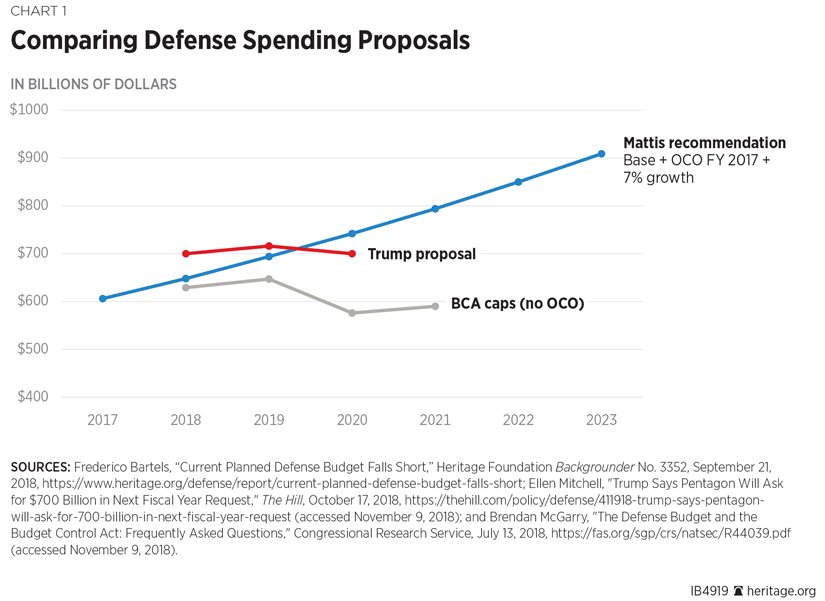On January 2018, Secretary of Defense James Mattis released the National Defense Strategy (NDS).REF It stated: “Long-term strategic competitions with China and Russia are the principal priorities for the Department, and require both increased and sustained investment, because of the magnitude of the threats they pose to U.S. security and prosperity today, and the potential for those threats to increase in the future.”REF
Further, back in the summer of 2017, when Secretary Mattis was discussing the budgetary needs to rebuild the military until 2023, he stated: “I would think it’s going to take a budget that’s probably up around five percent growth—real growth in order to get towards where we want to go[,] and not [less than] three percent will not do it. Three percent growth will not suffice, I’ll tell you that. It’s going to be up over five percent.”REF If you project the 5 percent annual real growth until 2020, the Pentagon would request a $742 billion budgetREF—which is not the number being currently discussed. It is a budgetary growth with which the Commission tasked with assessing the National Defense Strategy agreed.REF Their report further states that “the Commission assesses unequivocally that the NDS is not adequately resourced.”REF
In October 2018, President Donald Trump announced that the 2020 defense budget request would be $700 billion, a $16 billion decrease from 2019 and $33 billion below the request that was being prepared by the Department of Defense (DOD).REF If this request comes to fruition, it will be the end of the “increased and sustained investment” called for by the National Defense Strategy.
The 2020 defense budget will define the direction of our military’s rebuilding efforts.REF It will either continue—or stop it in its infancy. This paper highlights a few of the many obstacles that stand in the way of a 2020 defense budget that funds the military rebuild and enables the United States to develop the ability to counter Chinese and Russian aggression.
Trump’s Planned Defense Decrease
On October 26, Deputy Secretary of Defense Patrick Shanahan announced that the Department of Defense had begun working on a budget that reduces the topline budget from $716 billion in 2019 to $700 billion in 2020.REF This budget is being developed in parallel with the planned $733 billion request for 2020, which was been the Pentagon’s baseline since the release of its 2019 defense budget request. It is a real cut of 2.2 percent over the 2019 budget and a cut of 4.5 percent over the projected topline.
The request for a reduction comes very late in the budgetary process of the DOD, known internally as Planning, Programming, Budgeting and Execution, which, for the 2020 budget, likely started in September of 2017.REF This means that the Office of the Secretary of Defense will be responsible for finding the required reductions within the plans that each individual component and service has submitted. If the reductions are approved, the DOD will then have to go back to the services and re-synchronize the budget.
Operations and maintenance resources have been a usual target for sudden reductions in the planned budget, since these are resources that can be modulated without raising much congressional attention. Nonetheless, because Secretary Mattis has made near-term readiness a priority, it is unlikely that operations funding will be reduced in any meaningful way.REF Both readiness and lethality rely on operations and maintenance resources, so it is likely that the Secretary will want to preserve them.
As expressed by Mark Cancian, a defense analyst at the Center for Strategic and International Studies: “If DOD wants to preserve readiness, which is its highest stated priority, then it must cut modernization, force structure, and troop benefits.”REF It is very unlikely that Congress would allow the DOD to change troop benefits. It is also unlikely that either Congress or the Trump Administration would request a reduction in the force structure. Furthermore, the pace of force structure reductions would not enable demonstrable savings this year. This would leave modernization as the likely target of reductions.
Nonetheless, right now would not be a good moment to reduce modernization, since it would halt many projects necessary to engage in great-power competition. It is not yet defined what modernization programs the Pentagon is considering reducing, but they will not want to disrupt programs already in production. Thus, it is likely they would seek to reduce programs that have not yet entered full rate production or are in the development phase, like long-range precision fires or the new frigate.
The combination of the timing of the cuts in the Pentagon planning with the reduction themselves will likely force choices that either the Trump Administration or Congress will find unacceptable. The main question will be what priority defense will have in the upcoming budget negotiations.
Halting the Projected Growth
The Air Force recently announced that it needs to grow the number of its squadrons by 24 percent, from 312 to 386 by 2030.REF In order to increase the number of operational squadrons, the Air Force would have to increase in both people and platforms. It would involve the training of many new pilots and the purchase of new aircraft. These needs represent new demands for resources.
The Navy, on the other hand, has stated that it needs to grow to 355 ships,REF which, despite being an increase, is a number that is still not enough to meet all the demands currently placed on the service. A recent study by The Heritage Foundation puts the number of ships necessary to meet all Navy missions at 400.REF The need for increased ships and personnel in order to have a viable Navy will also pressure the defense budget.
The Army has stated they need to grow their active force “above 500,000” soldiers in order to satisfy demand and meet the needs of the National Defense Strategy.REF Further, the Army recently stood up the Army Futures Command in Austin, Texas, with the intent of focusing on the demands imposed by great-power competition and a more contemporary vision for the force.
The growth in these services is aimed at getting the nation better positioned for great-power competition—the imperative facing all of our military departments. Nonetheless, with the upcoming decrease in resources, the military would return to the mandate under the Obama Administration: “Do more with less.”REF
The Budget-Cap Question
Regardless of the amount of resources that the Trump Administration requests from Congress for defense, the Budget Control Act of 2011 caps are still the law of the land.REF For 2020, the cap is set at $576 billion, requiring a substantial increase to get to whatever level the Administration decides to request.
If you consider a $700 billion budget request with a $70 billion cap-exempt war account request in line with the previous two years, the Administration would have to negotiate a cap increase of $54 billion. On the other hand, if you consider a $733 billion budget request with only $20 billion in war funds, the Administration would be looking at negotiating a $137 billion increase. Overseas contingency operations should be reduced to true contingencies and be phased out, since they are qualitatively different from the base budget.REF These questions will be answered when the Administration releases its actual budget request in February 2019, but they will be decisive in setting the stage for the inevitable budget agreement negotiations.

New Congressional Leadership
Compared to the last time the budget caps were negotiated, both the House Armed Services and the Senate Armed Services Committees will be under new leadership. In the lower chamber, Ranking Member Adam Smith (D–WA) is likely to take the chairmanship. Smith has expressed on more than one occasion that the defense budget is too high and should see a dip in the coming years.REF It is likely that his committee will mark up the budget below the President’s budget request.
In the upper chamber, Senator Jim Inhofe (R–OK) is likely to remain as the Senate Armed Services Committee chairman, after the passing of Senator John McCain (R–AZ). The Senator has expressed the importance of properly resourcing defense and previously fought the budget cuts of the Obama Administration.REF Senator Inhofe will have to continue making the case for the defense budget.
The Path Forward
The 2020 defense budget will determine if the Trump Administration will be able to rebuild the military in any meaningful sense. As documented by The Heritage Foundation’s 2019 Index of U.S. Military Strength,REF the military has experienced some improvements in its readiness. But the military still has a long path ahead, and now is not the time to hang the “mission accomplished” banner on the rebuild.
As such, when defining the 2020 budget, Congress should:
- Conduct an independent evaluation. Representative Mac Thornberry (R–TX) and the late Senator John McCain (R–AZ) conducted independent assessments on the resources that the Pentagon would require for 2018 through 2022.REF This evaluation proved extremely important for the legislature to formulate its own opinion on the resources necessary to execute the DOD’s mission. At a time when the Pentagon seems to be changing the budget without changing the strategy, this evaluation could prove to be even more helpful. Congress needs to do the same type of homework for this coming budget.
- Consider the implications of the National Defense Strategy for the budget. As the plans for the Navy and the Air Force—and, to a degree, the Army—indicate, our current forces will require substantial investments in order to be ready for an era of great-power competition. Secretary Mattis stated that the budget would require annual 3 percent to 5 percent growth above inflation in order to meet the threats enunciated by the strategy.REF The high end of the growth described by the Secretary would put the 2020 defense budget number at $742 billion. If the U.S. is going to maintain its current defense strategy, it needs to properly fund it.
- Engage early in the debate on the budget cap. Everyone in Washington and in Congress understands that the defense budget caps are not enough to fund our defense requirements. There is no reason for Congress to wait for the last minute to ensure proper funding for defense. It is a chance for Congress to prioritize resources and to move away from the outrageous demand of increased non-defense simply because there is a real need to increase defense discretionary resources.REF The uncertainty created by prolonged negotiations and continuing resolutions has substantial costs to our national defense.REF If this budget deal is going to be better than the fiscally irresponsible Bipartisan Budget Act of 2018,REF it is important not to leave it to the last minute—when the choices are reduced to a government shutdown or increasing the debt.
Conclusion
Deputy Secretary Shanahan called the 2020 defense budget the “masterpiece” back in late 2017.REF He characterized the budget as such because it would be the first one that would be fully shaped by the National Defense Strategy and other defense reviews carried out by the Trump Administration.
It is also a chance to heed the warning of the Commission that assessed the NDS: “Without additional resources, and without greater stability and predictability in how those resources are provided, the Department will be unable to fulfill the ambition of the NDS or create and preserve U.S. military advantages in the years to come. There must be greater urgency and seriousness in funding national defense.”REF
Now with the announcement of a planned reduction in the defense budget, the 2020 request gains more weight, as it is determinant of the fate of the military rebuild. If Congress goes along with the reduction, the long-promised military rebuild will wither away.
—Frederico Bartels is Policy Analyst for Defense Budgeting in the Center for National Defense, of the Kathryn and Shelby Cullom Davis Institute for National Security and Foreign Policy, at The Heritage Foundation.

